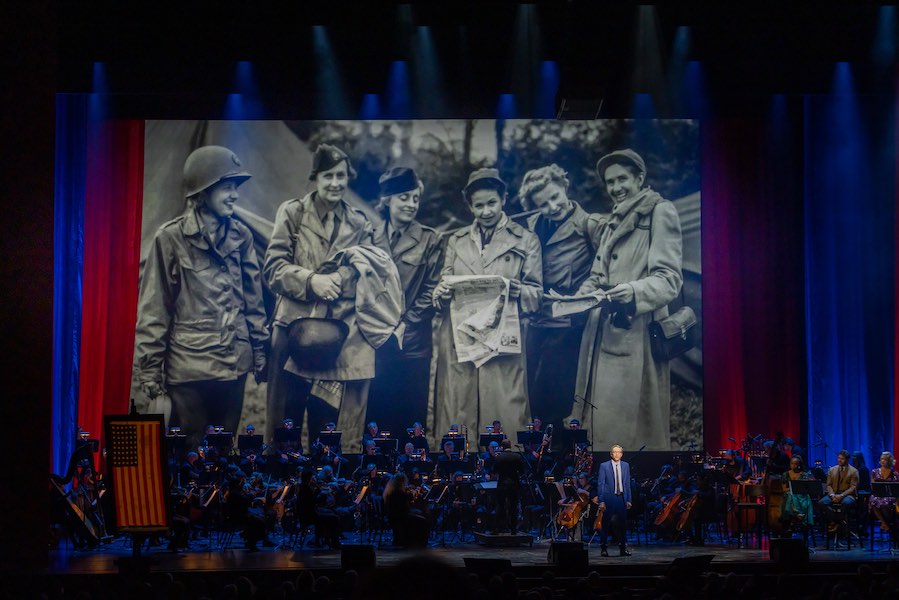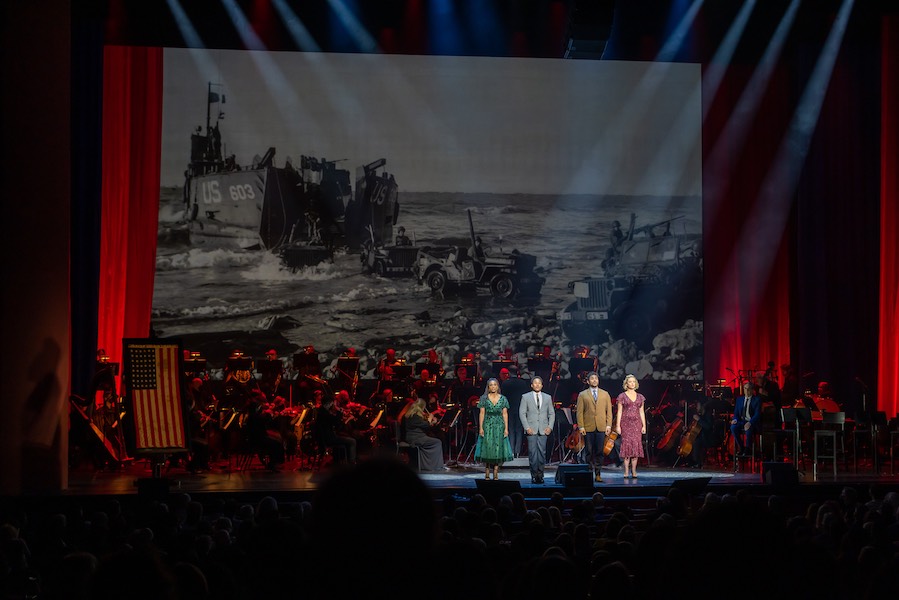There is a place for occasional performance — its function to celebrate a tribe, holiday, or event; to knit together community; or simply to remember a shared history. The Eyes of the World: From D-Day to VE Day at the John F. Kennedy Center for the Performing Arts on Saturday night was all of these.
I thought I knew what to expect. Our nation’s capital abounds in such occasional festivities — our annual Memorial Day concerts and Fourth of July events culminating in bang-up fireworks displays. Just downriver at the Lincoln Memorial, there was a concert the same night, Opera Italiana, celebrating Italians and Italian opera.
This was different.

For starters, there was something improvised and deliciously chaotic outside the Opera House as groups and individuals, still emerging from COVID isolation, tried to find each other and their tickets. Gold Star Mothers of more recent wars were milling around with a restless generation of twentysomething students who barely even knew about World War II, and they in turn with special guests such as the descendants of unsung African American women who had joined the war effort and faithfully continued to deliver mail to the troops in the weeks and months following the harrowing landing on Normandy Beach.
Officer Jonathan Sneed, on duty at the top of the red-carpeted stairs leading into the vast chandelier-lit auditorium, stepped into the fray to rally and lead the troops. “HOV lane over here,” he encouraged, and so us “soldiers” found holes in the KC’s well-fortified lines.
The event was woven together as from cloth, part concert of music from the period, part narrated history about the events following the invasion and push against Germany, and part stunning photographic series projected proscenium-wide from the “eyes” of correspondents sent there. The stories of the select group of these writers included some of the 20th century’s most famous personalities: Ernest Hemingway, Robert Capa, and Martha Gellhorn. Their involvement in the thick of things, including their interpersonal dramas, was very much part of the success of this woven multi-disciplinary performance piece. There was even a surprise “player” revealed, someone who for most of the evening was simply referred to as “Jerry” (and I was duped, confused if we were talking about a German spy, later revealed the guy was J.D. Salinger).
There was something profoundly personal in the feeling of the work, which was curated by historian John Monsky, who also ably narrated the evening. He had been enthralled with World War II flags as a young boy and assiduously tracked their journeys as both living history and sacred objects. His enthusiasm was catching. Each time he revealed the history of a flag that had flown over a particular landing craft, this piece of history was flown in high above the stage as a live relic, joining others in a spectacular exhibit of their own, and we all wanted to cheer at the conclusion of a revered “character arc.”
It’s all in the details Monsky has gathered: Eisenhower pacing the evening he has to call on or off D-Day due to weather conditions, knowing he may lose as many as 80 percent of his men in that operation; the 9,000 blue stars that turn to gold that fateful day; Capa’s photos capturing the fear and despair in the men’s eyes — and the artful way he later narrates the liberation of Paris, remarking on the elation on people’s faces, only to twist the knife as he tells us that most of the boys in the picture would die shortly thereafter fighting their way into Germany. Monsky is a historian who knows how to bring us into moment-to-moment emotional encounters.

Singers Adam Jacobs, Kristolyn Lloyd, Kate Rockwell, and Daniel Yearwood were all terrific in delivering the numbers, mostly in quartet arrangements, from the tight harmonies in 1940s popular music to tunes made famous by more recent Broadway shows.
I loved the more rare breakout solos that enriched the sound tapestry, such as the disturbing opening of Kander and Ebb’s “Tomorrow Belongs to Me,” sung in that high tenor’s sweet spot by Daniel Yearwood; Jacobs’s rendition of a young Merchant Marine Woody Guthrie’s galvanizing troops, many of whom would be facing an early death, with “What Are We Waiting For?” accompanied on solo guitar; Kate Rockwell’s sockin’ it to us with a Marlene Dietrich tribute in “The Boys in the Backroom”; and a stunning original rendition of “La vie en rose” by Kristolyn Lloyd. The performers also had turns bringing to life spoken text, as all too abrupt inserts.
Conductor Ian Weinberger led the Orchestra of St Luke’s, for which he also arranged and even composed some of the music. He captures the shifting emotional landscape from the terrifying rise of Hitler to the toe-tapping big band sound of Glenn Miller entertaining the troops. (Although Miller’s plane disappeared over the English Chanel, cutting short the life of this remarkable musician, we are reminded this phenom was The Beatles before the Beatles.) Then, all through music, Weinberger helps us go through the agonizing push north and east into Germany: the Battle of Hürtgen Forest and the poignant “Discovery of the Camp,” liberating the death camps. Weinberger retools certain melodies such as “The Caissons Go Rolling Along” to be an up-tempo march to a slogging-through-the-mud dirge. He is a master of delivering highly theatrical music, and his deft conducting of the Orchestra of St Luke’s gets maximum colors from these musicians.

The Eyes of the World: From D-Day to VE Day was intended as an immersive experience, in remembrance of what our country went through, and as such it very much succeeded. I had an uncle who was one of the few parachutists on D-Day to survive, but he was forever diminished and haunted by the experience. On behalf of this family of several veterans of WW II and for many other veteran families, especially now as that generation is all but gone, this work offers an important service.
Much from that period came as new information. As moving as it was as a live performance, it should also become a filmed event to reach generations yet to come about our history. The words tell the story; the music breaks open our hearts.
Running Time: 90 minutes with no intermission.
The Eyes of the World: From D-Day to VE Day was performed on June 4, 2022, in the John F. Kennedy Center for the Performing Arts Opera House, presented by the American Battle Monuments Commission and the New-York Historical Society.
The Eyes of the World: From D-Day to VE Day
Created and Narrated by John Monsky
Music Supervisor, Conductor, and Arranger: Ian Weinberger
Directed by Peter Flynn




